Motor Starters
Welcome to this EATON’s guide, which is about starters, devices that control the use of electrical power to equipment, usually a motor. As the name implies, starters “start” motors. They can also stop them, reverse them, accelerate them, and protect them.

Starters are made from two building blocks, contactors and overload protection:
- Contactors control the electric current to the motor. Their function is to repeatedly establish and interrupt an electrical power circuit.
- Overload Protection protects motors from drawing too much current and overheating, from literally “burning out.”
The Contactors
A contactor can stand on its own as a power control device, or as part of a starter. Contactors are used in applications ranging from the light switch to the most complex, automated industrial equipment.
Contactors are used by electrical equipment that is frequently turned off and on (opening and closing the circuit), such as lights, heaters, and motors.

Whatever the application, the function of the contactor is always the same: to make and break all power supply lines running to a load. Or, as defined by NEMA, to repeatedly establish and interrupt an electrical power circuit.
Here are the topics that we will cover:
- The Contactor (magnetic contactor, how the contactor operates, contact life etc.)
- Overload Protection (How motors work, what is an overload?, overload relay, tripping etc.)
- The Starter (magnetic motor starter, starter circuitry, types, standards and ratings etc.)
- Helping the Customer (NEMA or IEC?, checking the motor nameplate etc.)
| Title: | Basics Of Motor Starters And Contactors by EATON |
| Format: | |
| Size: | 649 KB |
| Pages: | 37 |
| Download: | Right here | Video Courses | Membership | Download Updates |



this is great ‘
Helps
Neutral
Namskar,
Thanks for your valuable information.